
“Simplicity is the ultimate sophistication.”
-Leonardo Da Vinci
Though bar training is a simple, stripped-down way of exercising, there’s still a lot going on. So far, we’ve pretty much only talked about the straight bar. However, the parallel bars are another key component of bar calisthenics. One of my most vivid adolescent memories is the first time I ever attempted a triceps dip on parallel bars. It was my freshman year of high school and I had just started to explore the wonderful world of working out. I signed up to take weight training my second semester that year and there was a dip station in the weight room, so I decided to give it a go. In theory, the parallel bar dip is a very simple exercise, so I felt confident approaching the bars. I grabbed the handles, jumped into the top position and braced myself for my first dip.
Once I began lowering down however, everything suddenly changed. I felt like someone had punched me hard in the sternum and rather than being able to press myself back up, I instead fell to the ground and recoiled in pain. At that point I was pretty sure I would NEVER be able to do a single dip on the bars. The few kids in gym class who could do one suddenly seemed like super-human deities.
I didn’t let that early experience stop me from trying again, however, and a few weeks later, I got my first real dip – it was a very exciting time! I’ve done a lot of dips since then and learned a lot of different variations. Dips are a great exercise and there are endless ways to keep them fresh and challenging. Pretty much any time you use your arms to press your body while in an upright position, it’s a dip.
Keep in mind that while dips emphasize the triceps, they also work your chest, shoulders and core muscles.
A great way for novices to work up towards full dips (and avoid the humiliation I felt after my first try) is by first practicing with the feet resting on the ground. This is most commonly done by placing your hands on a bench or a low bar held behind the back, with your hands in a pronated grip.

Beginners should start with their knees bent and feet flat on the floor. This allows you to push gently with your legs in order to give your arms some assistance. Make sure to hold your chest high. Don’t allow your shoulders to shrug upwards.

When low bar dips with your feet flat become easy, you can progress to doing them with your legs straight and your toes pointed up. Let your legs relax and allow your hips to hang down right below your shoulders. Your arms will have to do more of the work this way.
It might take a lot of practice for some people to get the feel for how to perform this move correctly. It is common for beginners to shrug their shoulders, lean over and hardly bend their elbows at all. Most of the time, these people have no idea that they are doing it until someone points it out and guides them through the proper range of motion. I can’t tell you how many times I’ve literally had to hold someone’s arms and physically bend their elbow for them to perform the correct movement pattern. It’s always helpful to videotape yourself in order to objectively assess your form. Nowadays everyone has a camcorder in their phone, so it shouldn’t be too hard.
Dip form checklist: shoulders down, chest up, elbows bent.
Improper dip form: Shoulders shrugged, chest caved it, minimal elbow flexion.
The jump from low bar dips to full parallel bar dips can be a big hurdle. You’ll likely need to be able to do at least 20 on the low bar before you’ll manage even one dip on the parallel bars. Some may get there quickly (young men especially), but it will take longer for others. Don’t be in a rush to get to the finish. One step at a time, one rep at a time.
Once you can comfortably perform many dips with your feet resting on the ground you will be ready to attempt the real deal. The parallel bar set-up is the gold standard for the triceps dip exercise. Like pull-ups (and most of the exercises in this book for that matter), dips will be more difficult for women than they are for men. They are still amongst the best exercises for either gender.
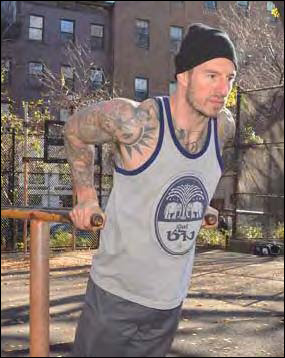
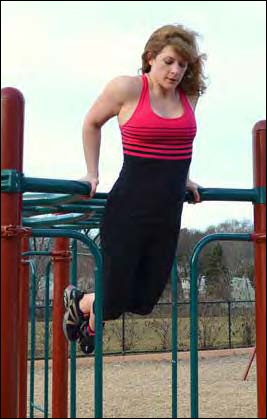
Dip it good!
The parallel bar set-up is the gold standard for the triceps dip exercise.
Like pull-ups, dips will be more difficult for women than they are for men. They are still amongst the best exercises for either gender.
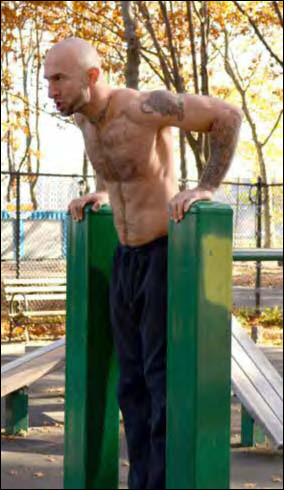
When performing parallel bar dips, you’ll need to tilt forward at the torso. Your elbows should stay more or less over your hands, so your shoulders will wind up in front of them. You can vary the degree to which you do this, and doing so can change the emphasis. The more you lean forward the more you are working your chest. The more upright you stay, the more you work your triceps and core. Trying to stay totally vertical is not advised, however, as doing so can put unnecessary strain on your shoulders. Unless you’re really, really strong.

The more you lean forward the more you are working your chest. The more upright you stay, the more you work your triceps and core.
It is worth noting that the distance between the bars and thickness of the grip will effect the difficulty of the exercise. Beginners are better off using thinner bars spaced fairly far apart (20-24 inches), while closer bars (anything closer than 18 or 19 inches is pretty narrow) will provide increased difficulty.

The parallel bars at Tompkins Square Park in NYC are pretty narrow, which makes for a very challenging workout!
Straight bar dips are another challenging and worthwhile variation. As the name implies, the straight bar dip is performed with both hands on a single straight bar positioned in front of the body. When you do a parallel bar dip, you dip in between the bars, but when you dip on a straight bar, your body must move around the bar. As you lower yourself down, you’ll need to reach your legs out in front a bit to keep balance.
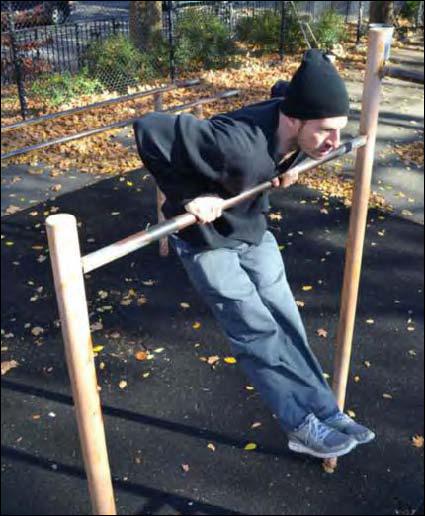
As you lower yourself down, you’ll need to reach your legs out in front a bit to keep balance.
The straight bar dip is one of the more challenging dip variations and one of the most specific precursors to the muscle-up. You should start working on these once you can do a few reps on the parallel bars.
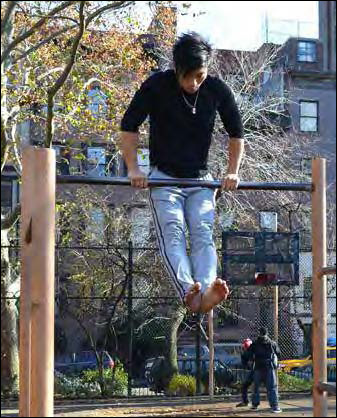
The straight bar dip is one of the more challenging dip variations and one of the most specific precursors to the muscle-up.
You can also split the difference between the parallel bars and the straight bar by practicing your dips on two perpendicular bars. Feel free to get creative with everyday scenarios if you don’t have access to formal workout equipment.
Dips on the perpendicular bars and parallel bars are very similar, though they each have their own nuances. Just like with parallel bars, playing around with how far forward you lean can effect the subtleties of muscle recruitment. Lean forward for more chest, stay upright for more triceps and abs. The perpendicular bar set-up can allow you to stay more upright without the potential shoulder strain. Just make sure you are strong enough to handle this variation before you start trying to rep out.

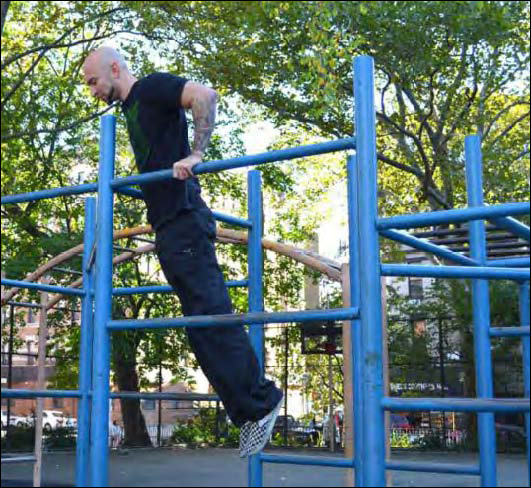
A Korean dip is a behind the back dip on a high bar. It’s almost like the low bar dip I talked about earlier, except your feet are in the air!
This is one of the hardest dip variations, so I suggest getting very comfortable with the others before attempting the Korean dip. You should be able to perform at least fifteen consecutive parallel or perpendicular bar dips first. Because it is difficult to control your body from this angle, you’ll really need to focus on engaging your abs and lower back muscles to stabilize. It also helps to keep your hamstrings and glutes contracted. Having the bar behind you can give your shoulders a deep stretch as well, so make sure you are warmed up. The Korean dip is really a full body exercise.
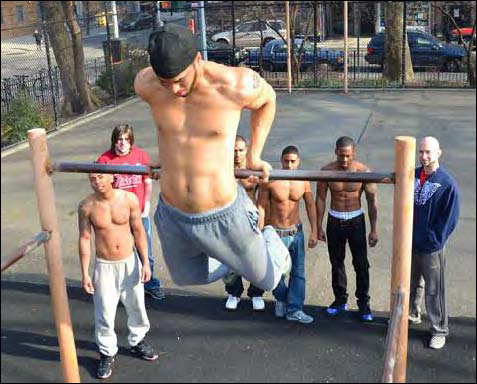
The Korean dip is one of the hardest dip variations.
Also known as a Russian dip, the hinge dip starts out like a standard parallel bar dip. When you reach the bottom of the normal range of motion, shift your weight back onto your elbows, putting your forearms in contact with the bars. Then shift your weight back onto your hands and press yourself up.
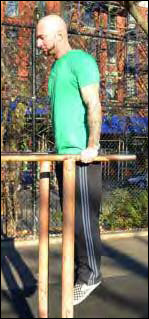
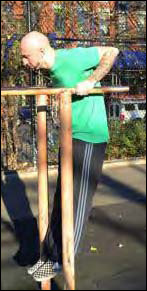
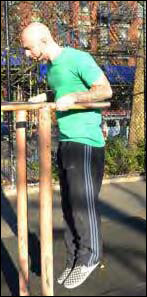
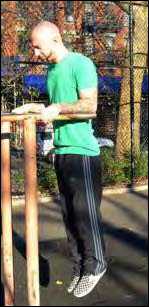
When you reach the bottom of the normal range of motion, shift your weight back onto your elbows, putting your forearms in contact with the bars.
To make hinge dips even more difficult, you can extend the range of motion by sliding your entire body out until your arms are straight. It’s helpful to contract your abs and reach your legs out in front of your trunk when sitting back all the way into a sliding hinge dip. If you let your upper arm come off the bar as you lean back, the exercise will become more difficult. Very advanced practitioners may also be able to perform a forward sliding hinge dip onto the shoulders.

It’s helpful to contract your abs and reach your legs out in front of your trunk when sitting back all the way into a sliding hinge dip.
Very advanced practitioners may also be able to perform a forward sliding hinge dip onto the shoulders.
Sometimes referred to as “jump training,” the term plyometrics refers to any type of explosive exercise. Any time you get your body airborne you are doing a plyo. Once you’re very strong and confident with the previous variations, you can start working on plyometric dips. I’d suggest being able to do at least thirty reps on the parallel bars first.
The idea with a plyo-dip is simply to push your body away from the bar(s) at the top of the rep. Use your hips and put your entire body into it. There’s no way to do a slow controlled jump, so move fast and explosively. Eventually you’ll get a feel for catching some air and you can experiment with clapping dips and other freestyle variations. The sky is the limit!
Any time you get your body airborne you are doing a plyo.
The sky is the limit!